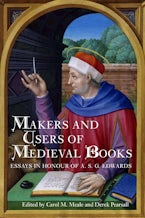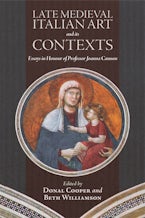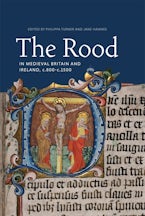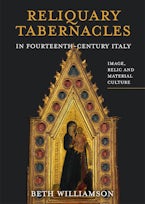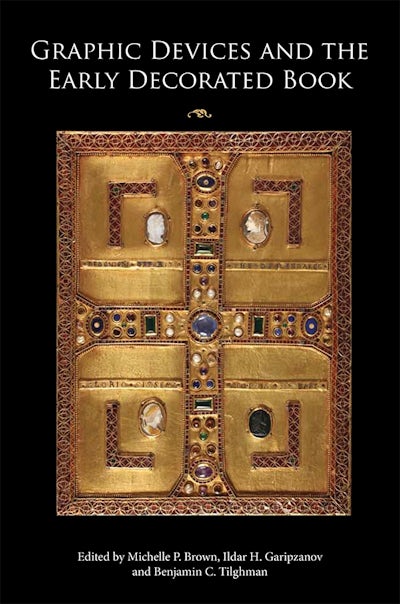
Title Details
316 Pages
24 x 17 cm
76 colour, 7 b/w illus.
Series: Boydell Studies in Medieval Art and Architecture
Series Vol. Number:
11
Imprint: Boydell Press
Graphic Devices and the Early Decorated Book
- Description
- Contents
- Reviews
Examinations of the use of diagrams, symbols etc. found as commentary in medieval texts.
In our electronic age, we are accustomed to the use of icons, symbols, graphs, charts, diagrams and visualisations as part of the vocabulary of communication. But this rich ecosystem is far from a modern phenomenon. Early medievalmanuscripts demonstrate that their makers and readers achieved very sophisticated levels of "graphicacy". When considered from this perspective, many elements familiar to students of manuscript decoration - embellished charactersin scripts, decorated initials, monograms, graphic symbols, assembly marks, diagrammatic structures, frames, symbolic ornaments, musical notation - are revealed to be not minor, incidental marks but crucial elements within the larger sign systems of manuscripts.
This interdisciplinary volume is the first to discuss the conflation of text and image with a specific focus on the appearance of various graphic devices in manuscript culture. By looking attheir many forms as they appear from the fourth century to their full maturity in the long ninth century, its contributors demonstrate the importance of these symbols to understanding medieval culture.
Michelle P. Brown FSA is Professor Emerita of Medieval Book History at the School of Advanced Study, University of London and was formerly the Curator of Illuminated Manuscripts at the British Library; Ildar Garipzanov is Professor of Early Medieval History at the Department of Archaeology, Conservation and History at the University of Oslo; Benjamin C. Tilghman is Assistant Professor of Art History at Washington College.
Contributors: Tina Bawden, Michelle P.Brown, Leslie Brubaker, David Ganz, Ildar H. Garipzanov, Cynthia Hahn, Catherine E. Karkov, Herbert L. Kessler, Beatrice Kitzinger, Kallirroe Linardou, Lawrence Nees, Eric Palazzo, Benjamin C. Tilghman.
In our electronic age, we are accustomed to the use of icons, symbols, graphs, charts, diagrams and visualisations as part of the vocabulary of communication. But this rich ecosystem is far from a modern phenomenon. Early medievalmanuscripts demonstrate that their makers and readers achieved very sophisticated levels of "graphicacy". When considered from this perspective, many elements familiar to students of manuscript decoration - embellished charactersin scripts, decorated initials, monograms, graphic symbols, assembly marks, diagrammatic structures, frames, symbolic ornaments, musical notation - are revealed to be not minor, incidental marks but crucial elements within the larger sign systems of manuscripts.
This interdisciplinary volume is the first to discuss the conflation of text and image with a specific focus on the appearance of various graphic devices in manuscript culture. By looking attheir many forms as they appear from the fourth century to their full maturity in the long ninth century, its contributors demonstrate the importance of these symbols to understanding medieval culture.
Michelle P. Brown FSA is Professor Emerita of Medieval Book History at the School of Advanced Study, University of London and was formerly the Curator of Illuminated Manuscripts at the British Library; Ildar Garipzanov is Professor of Early Medieval History at the Department of Archaeology, Conservation and History at the University of Oslo; Benjamin C. Tilghman is Assistant Professor of Art History at Washington College.
Contributors: Tina Bawden, Michelle P.Brown, Leslie Brubaker, David Ganz, Ildar H. Garipzanov, Cynthia Hahn, Catherine E. Karkov, Herbert L. Kessler, Beatrice Kitzinger, Kallirroe Linardou, Lawrence Nees, Eric Palazzo, Benjamin C. Tilghman.
Introduction: The Role of Graphic Devices in Understanding the Early Decorated Book
"In the Image and Likeness of God": The Dedication Monogram in the Calendar of 354 and Early Medieval Monogrammatic Initials - Ildar Garipzanov
'Character' and the Power of the Letter - David Ganz
Tangled Voices: Writing, Drawing and the Anglo-Saxon Decorated Initial - Catherine E. Karkov
Graphic Visualization in Liturgical Manuscripts in the Early Middle Ages: The Initial "O" in the Sacramentary of Gellone - Eric Palazzo
Graphic Quire Marks and Qur'anic Verse Markers in Frankish and Islamic manuscripts from the Seventh and Eighth Centuries - Lawrence Nees
The Graphic Cross as Salvific Mark and Organizing Principle: Making, Marking, Shaping - Cynthia Hahn
The Visual Rhetoric of Insular Decorated Incipit Openings - Michelle Brown
The Relationship between Letter and Frame in Insular and Carolingian Manuscripts - Tina Bawden
Patterns of Meaning in Insular Manuscripts: folio 183r in the Book of Kells - Benjamin C. Tilghman
Graphic and Figural Representation in Touronian Gospel Illumination - Beatrice Kitzinger
Meaning from the Margins: Graphic Signs, Frames and Initials in a ninth-century Byzantine Manuscript - Leslie Brubaker
An Exercise in Extravagance and Abundance: Some Thoughts on the Marginalia Decorata in the Codex Parasinus graecus 216 - Kallirroe Linardou
The Cross on the Book: Diagram, Ornament, Materiality - David Ganz
Graphic Glosses and Argumentative Ornament - Herbert Kessler
Bibliography
"In the Image and Likeness of God": The Dedication Monogram in the Calendar of 354 and Early Medieval Monogrammatic Initials - Ildar Garipzanov
'Character' and the Power of the Letter - David Ganz
Tangled Voices: Writing, Drawing and the Anglo-Saxon Decorated Initial - Catherine E. Karkov
Graphic Visualization in Liturgical Manuscripts in the Early Middle Ages: The Initial "O" in the Sacramentary of Gellone - Eric Palazzo
Graphic Quire Marks and Qur'anic Verse Markers in Frankish and Islamic manuscripts from the Seventh and Eighth Centuries - Lawrence Nees
The Graphic Cross as Salvific Mark and Organizing Principle: Making, Marking, Shaping - Cynthia Hahn
The Visual Rhetoric of Insular Decorated Incipit Openings - Michelle Brown
The Relationship between Letter and Frame in Insular and Carolingian Manuscripts - Tina Bawden
Patterns of Meaning in Insular Manuscripts: folio 183r in the Book of Kells - Benjamin C. Tilghman
Graphic and Figural Representation in Touronian Gospel Illumination - Beatrice Kitzinger
Meaning from the Margins: Graphic Signs, Frames and Initials in a ninth-century Byzantine Manuscript - Leslie Brubaker
An Exercise in Extravagance and Abundance: Some Thoughts on the Marginalia Decorata in the Codex Parasinus graecus 216 - Kallirroe Linardou
The Cross on the Book: Diagram, Ornament, Materiality - David Ganz
Graphic Glosses and Argumentative Ornament - Herbert Kessler
Bibliography
"Provides a much-needed modern exploration of the potential function and meaning behind decoration within early medieval manuscripts....it will surely be of great use to researchers in a wide range of disciplines, from paleography to history and art history." EARLY MEDIEVAL EUROPE
"The . . . fourteen studies, all excellent, address a range of innovations to which nascent book cultures, from the fourth century through the end of the first millennium, gave rise." SPECULUM
Hardcover
9781783272266
October 2017
£85.00 / $125.00
Ebook (EPDF)
9781787441484
October 2017
£24.99 / $29.95
Title Details
316 Pages
2.4 x 1.7 cm
76 colour, 7 b/w illus.
Series: Boydell Studies in Medieval Art and Architecture
Series Vol. Number:
11
Imprint: Boydell Press




